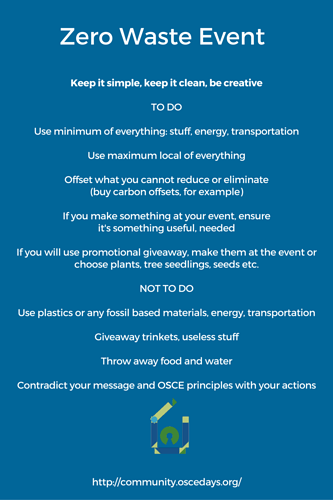
##WELCOME to the OSCEdays global Zero Waste Event Challenge and Tutorial!
Events can produce a lot of waste! And this is of course counterproductive to the goals and questions of the OSCEdays. But there are alternatives. Practices for having zero or low waste events have been developed and tested. And we invite all local organizers to run their event in such a way and connect with the lessons learned by the other events.
The Global Challenge: Below you can find a tutorial with simple instructions on how to run a Zero Waste event. We invite you to follow the steps. And if you do so, report back the results to us (by posting your participation, the reporting document and what you learned, in the comments below).
Let’s make OSCEdays 2016 a global clean event together and support each other in doing that.
###SHORT TUTORIAL
Keep it simple, keep it clean, be creative
To do
-
Use minimum of everything: stuff, energy, transportation
-
Use maximum local of everything
-
Offset what you cannot reduce or eliminate (buy carbon offsets, for example)
-
If you make something at your event, ensure it’s something useful, needed
-
If you will use promotional giveaway, make them at the event or choose plants, tree seedlings, seeds, etc.
Not to do
-
Use plastics or any fossil based materials, energy, transportation
-
Giveaway trinkets, useless stuff
-
Throw away food and water
-
Contradict your message and the OSCE principles with your actions
###DETAILED TUTORIAL
How to run an OSCEdays Event as Zero Waste Event
#Why organize a Zero Waste Event?
Festivals and conferences create an insane amount of waste. It’s important ensure that during the 5 days we will actually do our best to reduce the amount of waste that ends in a landfill, and raise awareness among all the stakeholders. This Zero Waste approach is also a good opportunity to put into practice the OSCE days values: rethink our behaviors towards waste and share the best practices with everyone.
How great it would be:
- To know exactly where the trash goes when it leaves the event?
- To know how much waste has been recycled and did not end in the landfill for all the 60+ participating cities?
- To exchange best practices with other cities and increase our waste diversion rate next year ?
#How to do it?
####(1) Understand and Familiarize with these basic Terms and Principles
-
Waste Upstream: Preventing waste creation at its source (the best scenario). The principle of source reduction eliminates waste at its source.
-
Waste Downstream: Once waste has been created, handling it in an environmentally responsible way by re-channeling materials into reuse and new production.
-
Recycling: Processes used materials into new products to divert waste from the landfill.
-
Composting: Turns organics such as food scraps, yard waste, and paper back into soil that can be used to grow new plants and crops.
-
Landfill: Replace the word garbage with landfill. Garbage implies a mix of everything hidden in a large black can. Zero waste asks you to think of what is in that can that should/could be somewhere else.
-
Landfill diversion: Keeping valuable resources out of the landfill by using less, reusing, recycling, composting, and more.
-
Resource recovery: When discarded materials are viewed in the context of global resource depletion, resource recovery refers to a rerouting of these valuable materials to create a cyclical system of reuse, like the one found in nature.
####(2) Find An Ambassador Per City
To Set up the Zero Waste Event, Communicate it & to Report Results.
####(3) 2 Tools to use
- The Check List Check List Zero Waste Event - OSCE days 2016.xls (191 KB)
- The Reporting Document
####(4) Follow These 3 Steps
- PRE-EVENT PLANNING
- DAY OF EVENT
- AFTER THE EVENT
The steps are explained in detail below
#The 3 Steps
##1. PRE-EVENT-PLANNING
###Zero Waste Ambassador
One person should be in charge of the ZWE approach. This is the Zero Waste Ambassador. The tasks of this person are:
- Follow the check list
- Inform visitors during the event
- Measure waste collected + create reporting
- Eventually coordinate the volunteers
- Celebrate zero waste success
- Venue Selection: Venues that have experience in reducing waste or other sustainability practices will already have some of the key components in place, including sorting/collection containers and contracts with a hauler to take compostable materials following the event
- Take measures to Minimize Waste Upstream. (see below)
###Food: Reusable/Compostable/Disposable Serving Ware
- Decide whether you will require vendors/caterers to provide their own reusable or compostable serving ware (plates, cups, etc.) or whether you (the event organizer) will provide these items.
- Require that vendors/caterers provide drinks and condiments (water, tea, sugars, ketchup, salad dressings, etc.) in bulk instead of in individual packages and servings.
- Ask that vendors/caterers serve less or no meat, dairy, and greasy food items, as these are less easily compostable. Also encourage caterers to serve local, organic, and sustainable food whenever possible.
- Research beforehand what certain places will accept and how soon after the event they will need the donated food.
###Marketing, Publicity, and Invitations: Electronic vs. Paper/Mailing
Incorporate waste diversion messages by using:
- An official event website
- An official event Facebook account or event page
- An official event printed material (flyer,poster, postcard, etc. made from recycled content)
- Other publicity through Twitter, YouTube, press release, newsletters, ads, etc.
###Resource Recovery Stations
These are what you might consider “waste” sorting stations at a zero waste event or venue. At a zero waste event there is no such thing as a waste bin or trash can. You’ll only find a Resource Recovery Station, a fully-loaded sorting center complete with collection bins for all types of recyclable items, compostable and organic items, and the little waste that cannot be reused, recycled, or composted.
Each station will need collection bins based on the items you are collecting:
(1) Reusables
(2) Liquids
(3) Recyclables
(4) Compostables/Organics
(5) Landfill
Procuring Supplies for the Resource Recovery Stations:
- Bags: Color-coded bags help guests properly sort their discards.
- Signs: You will want two kinds of signs at your zero waste event:
- Venue Map
Once you have determined the number of Resource Recovery Stations, you will need to map out their locations within the venue. You will need to consider the layout of the venue and where food and beverages are being served and consumed.
##2. DAY(S) OF EVENT
###Event Set-Up
- Set up Resource Recovery Stations with Sorting containers and signs for Reusables, Liquids, Recyclables, Compostables/Organics, Landfill as described above.
- Make sure supplies are at each sorting station (extra bags, tape, gloves, etc.).
- Hang/ set up zero waste education signs
###On-going
Do this while the event is running:
- Conduct zero waste education
- Monitor stations
- Empty/remove full containers
- Tear Down
- Final sweep
- Final measurements
- Clean up
##3. AFTER THE EVENT
###Downstream
- Leftover food: Encourage attendees to bring any leftover food home using reusable containers. Research opportunities to donate any untouched, unopened food to local food shelters, food pantries, or churches.
-
Compost any remaining compostable items. -
Haul or take compostables to end site (Land & Lakes). -
Return rented reusables. -
Store extra supplies (waste station materials, reusables, etc.) or donate.
###Evaluation
Complete the reporting document to assess the amount waste diversion from landfill
-
Tracks materials from the event to the recycling or composting facility -
Provides information on how many materials were recycled or composted, as compared to total waste generated, in order to come up with an overall diversion rate for the event -
Explains your zero waste approach and highlights the consequent cost savings of the event’s zero waste efforts -
Includes attendee and vendor comments
###Post
- Event Publicity and Thank You’s: Follow-up with electronic thank you notes to continue the trend of zero waste.
-
Publicizing your zero waste successes and explaining how these successes were measured - Noting any revisions and recommendations for future zero waste events

